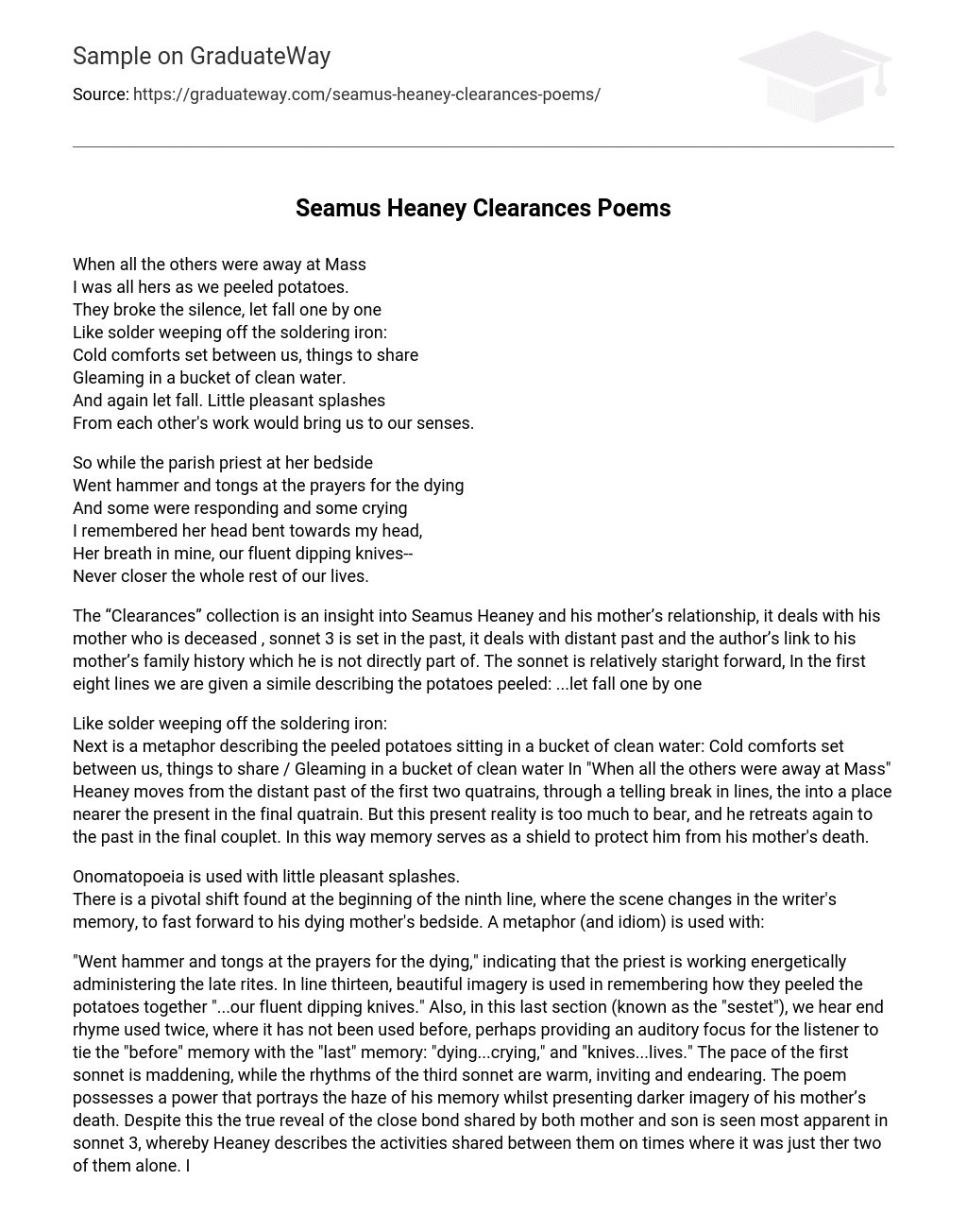When all the others were away at Mass
I was all hers as we peeled potatoes.
They broke the silence, let fall one by one
Like solder weeping off the soldering iron:
Cold comforts set between us, things to share
Gleaming in a bucket of clean water.
And again let fall. Little pleasant splashes
From each other’s work would bring us to our senses.
So while the parish priest at her bedside
Went hammer and tongs at the prayers for the dying
And some were responding and some crying
I remembered her head bent towards my head,
Her breath in mine, our fluent dipping knives–
Never closer the whole rest of our lives.
The “Clearances” collection is an insight into Seamus Heaney and his mother’s relationship, it deals with his mother who is deceased , sonnet 3 is set in the past, it deals with distant past and the author’s link to his mother’s family history which he is not directly part of. The sonnet is relatively staright forward, In the first eight lines we are given a simile describing the potatoes peeled: …let fall one by one
Like solder weeping off the soldering iron:
Next is a metaphor describing the peeled potatoes sitting in a bucket of clean water: Cold comforts set between us, things to share / Gleaming in a bucket of clean water In “When all the others were away at Mass” Heaney moves from the distant past of the first two quatrains, through a telling break in lines, the into a place nearer the present in the final quatrain. But this present reality is too much to bear, and he retreats again to the past in the final couplet. In this way memory serves as a shield to protect him from his mother’s death.
Onomatopoeia is used with little pleasant splashes.
There is a pivotal shift found at the beginning of the ninth line, where the scene changes in the writer’s memory, to fast forward to his dying mother’s bedside. A metaphor (and idiom) is used with:
“Went hammer and tongs at the prayers for the dying,” indicating that the priest is working energetically administering the late rites. In line thirteen, beautiful imagery is used in remembering how they peeled the potatoes together “…our fluent dipping knives.” Also, in this last section (known as the “sestet”), we hear end rhyme used twice, where it has not been used before, perhaps providing an auditory focus for the listener to tie the “before” memory with the “last” memory: “dying…crying,” and “knives…lives.” The pace of the first sonnet is maddening, while the rhythms of the third sonnet are warm, inviting and endearing. The poem possesses a power that portrays the haze of his memory whilst presenting darker imagery of his mother’s death. Despite this the true reveal of the close bond shared by both mother and son is seen most apparent in sonnet 3, whereby Heaney describes the activities shared between them on times where it was just ther two of them alone. In sonnet 3, he mentions himself and his mother preparing Sunday Dinner ‘I was all hers as we peeled potatoes’. ‘They broke the silence, let fall one by one’.
The close bond between them is easily spotted here as peeling potatoes is seen as a feminine image, yet Heany is eager to help and share quality time with his mother, emphasising the importane she has in his life. The fact there is silence also indicates their loving relationship, as neither feel the need to speak and are bothe just enjoying each others company. ‘From each other’s work would bring us to our senses’, this yet again shows the unifying element between the both of them, almost as if part of one another, showing how alike they are. The change in the mood in the second stanza emphasises Heaney’s great pain at the loss of his mother. Yet, despite this they are still as united as they were in the first stanza , ‘her breath is mine’ once again highlighting the love shared between the two of them. The final line is a confirmation of the bond between Heaney and his mother as he feels the closest he has ever felt at a time when he should feel distanced by her death, ‘never closer the whole rest of our lives’
View as multi-pages





